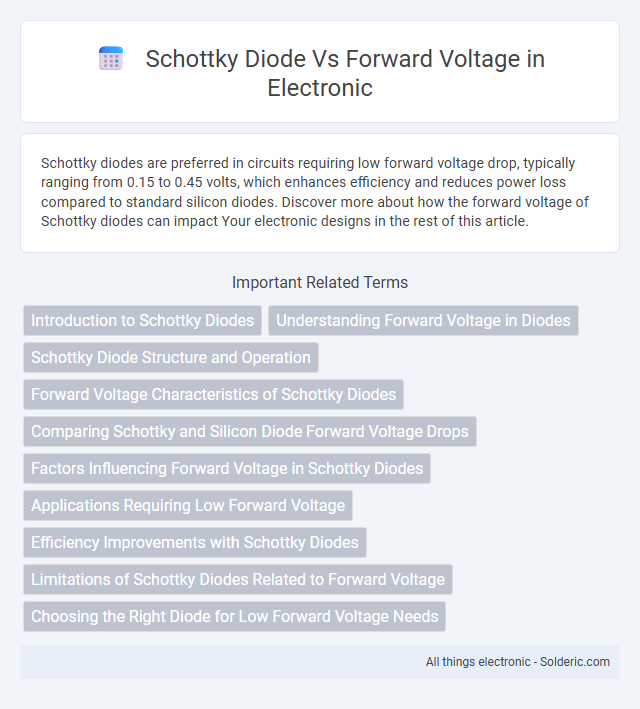Schottky diodes are preferred in circuits requiring low forward voltage drop, typically ranging from 0.15 to 0.45 volts, which enhances efficiency and reduces power loss compared to standard silicon diodes. Discover more about how the forward voltage of Schottky diodes can impact Your electronic designs in the rest of this article.
Comparison Table
| Feature | Schottky Diode | Forward Voltage |
|---|---|---|
| Definition | A semiconductor diode with low forward voltage drop and fast switching. | The voltage drop across a diode when it is forward biased and conducting current. |
| Typical Forward Voltage | 0.15V to 0.45V | Varies by diode type: Silicon (~0.7V), Schottky (~0.15-0.45V), LED (1.8V+) |
| Material | Metal-semiconductor junction (commonly metal-Silicon) | N/A (property of diode operation) |
| Switching Speed | Very fast, suitable for high-frequency applications | N/A (related to diode characteristics) |
| Power Efficiency | Higher efficiency due to lower forward voltage drop | Lower forward voltage reduces power loss in circuits |
| Applications | Power supplies, RF circuits, voltage clamping | Important parameter in diode selection for circuits |
Introduction to Schottky Diodes
Schottky diodes are semiconductor devices known for their low forward voltage drop, typically ranging from 0.15 to 0.45 volts, which enhances efficiency in power-sensitive applications. Unlike traditional PN junction diodes, Schottky diodes utilize a metal-semiconductor junction, resulting in faster switching speeds and reduced power loss. Understanding the characteristics of Schottky diodes can help optimize your electronic circuit designs by minimizing voltage drop and heat generation.
Understanding Forward Voltage in Diodes
Schottky diodes exhibit lower forward voltage (typically 0.15 to 0.45 volts) compared to standard silicon diodes, which usually have a forward voltage of around 0.7 volts. This reduced forward voltage leads to higher efficiency and lower power dissipation in circuits, making Schottky diodes ideal for high-speed switching and low voltage drop applications. Understanding forward voltage is crucial in diode selection, as it directly affects the energy loss and thermal performance within electronic devices.
Schottky Diode Structure and Operation
Schottky diodes feature a metal-semiconductor junction instead of the typical p-n junction, resulting in a lower forward voltage drop, usually between 0.15 to 0.45 volts, compared to standard silicon diodes. This structural difference allows for faster switching speeds and higher efficiency by minimizing energy loss during conduction. Your circuits benefit from reduced forward voltage and improved response time, making Schottky diodes ideal for power-sensitive and high-frequency applications.
Forward Voltage Characteristics of Schottky Diodes
Schottky diodes exhibit lower forward voltage drop values, typically ranging from 0.15 to 0.45 volts, which is significantly less than that of standard silicon diodes. This characteristic results from the metal-semiconductor junction, enabling faster switching speeds and reduced power loss during conduction. The forward voltage drop remains relatively stable across varying forward current levels, making Schottky diodes efficient for low-voltage and high-frequency applications.
Comparing Schottky and Silicon Diode Forward Voltage Drops
Schottky diodes feature a significantly lower forward voltage drop, typically ranging from 0.15 to 0.45 volts, compared to silicon diodes, which usually have a forward voltage drop around 0.7 volts. This lower forward voltage drop in Schottky diodes results in higher efficiency and reduced power loss in circuits where minimizing voltage drop is crucial. Selecting a Schottky diode for your design can improve performance in high-speed switching and low-voltage applications due to its fast recovery time and lower conduction losses.
Factors Influencing Forward Voltage in Schottky Diodes
Forward voltage in Schottky diodes is influenced by the metal-semiconductor junction material, which determines the barrier height and directly affects voltage drop. Temperature variations impact forward voltage by altering carrier mobility and barrier height, typically causing a decrease in forward voltage with rising temperature. The doping concentration of the semiconductor and diode current levels also play critical roles, as higher doping reduces barrier height, while increased forward current leads to voltage rise due to resistive losses.
Applications Requiring Low Forward Voltage
Schottky diodes are preferred in applications requiring low forward voltage due to their metal-semiconductor junction, which typically results in a forward voltage drop of 0.2 to 0.3 volts, significantly lower than standard silicon diodes. This low forward voltage characteristic enhances efficiency and reduces power loss in power rectification, switching power supplies, and voltage clamping circuits. Devices such as solar panel arrays, radio frequency mixers, and high-speed digital circuits benefit from Schottky diodes to maintain performance while minimizing heat generation and energy waste.
Efficiency Improvements with Schottky Diodes
Schottky diodes exhibit significantly lower forward voltage drop, typically around 0.2 to 0.3 volts, compared to standard silicon diodes at 0.7 volts, which enhances energy efficiency in power circuits. This reduced forward voltage results in lower power dissipation and increased overall system efficiency, especially in high-frequency switching applications. Consequently, Schottky diodes are preferred in power supplies and photovoltaic systems where minimizing energy loss and improving thermal performance are critical.
Limitations of Schottky Diodes Related to Forward Voltage
Schottky diodes exhibit lower forward voltage (typically 0.15 to 0.45 volts) compared to standard silicon diodes, enabling faster switching and reduced power loss in electronic circuits. However, the forward voltage of Schottky diodes is limited by their semiconductor material and junction properties, causing higher reverse leakage current at elevated temperatures. This leakage current imposes constraints on their use in high-voltage or high-temperature applications, resulting in trade-offs between efficiency and thermal stability.
Choosing the Right Diode for Low Forward Voltage Needs
Schottky diodes are ideal for applications requiring low forward voltage due to their metal-semiconductor junction, typically exhibiting forward voltages between 0.2 to 0.3 volts, significantly lower than standard silicon diodes that range around 0.7 volts. When choosing the right diode for your low forward voltage needs, consider the Schottky diode's fast switching speed and reduced power loss, which enhance efficiency in power-sensitive circuits. Your selection should balance forward voltage characteristics with current rating and reverse leakage to ensure optimal performance in your specific application.
Schottky diode vs Forward voltage Infographic

 solderic.com
solderic.com